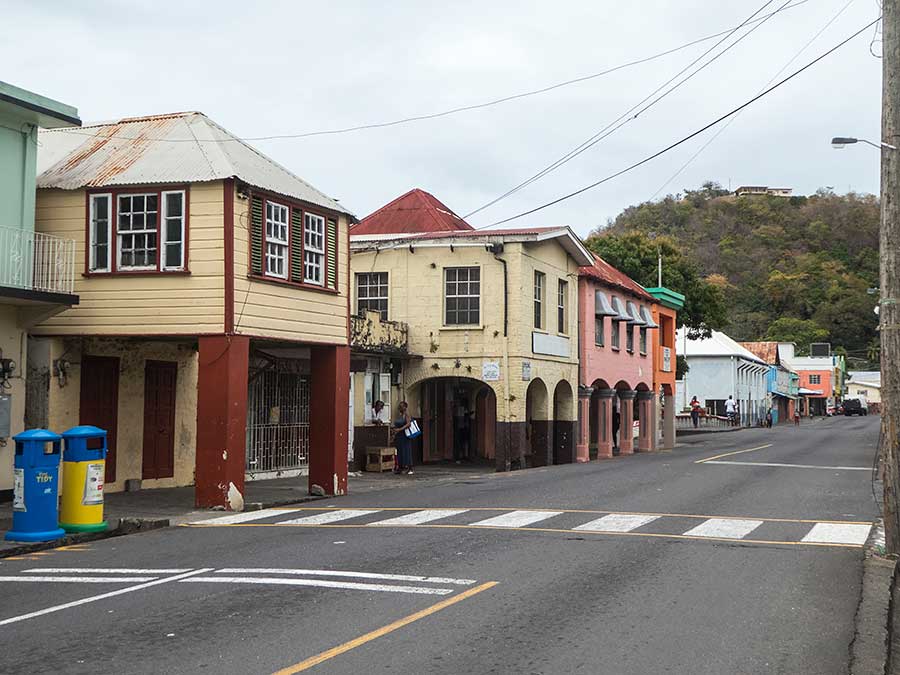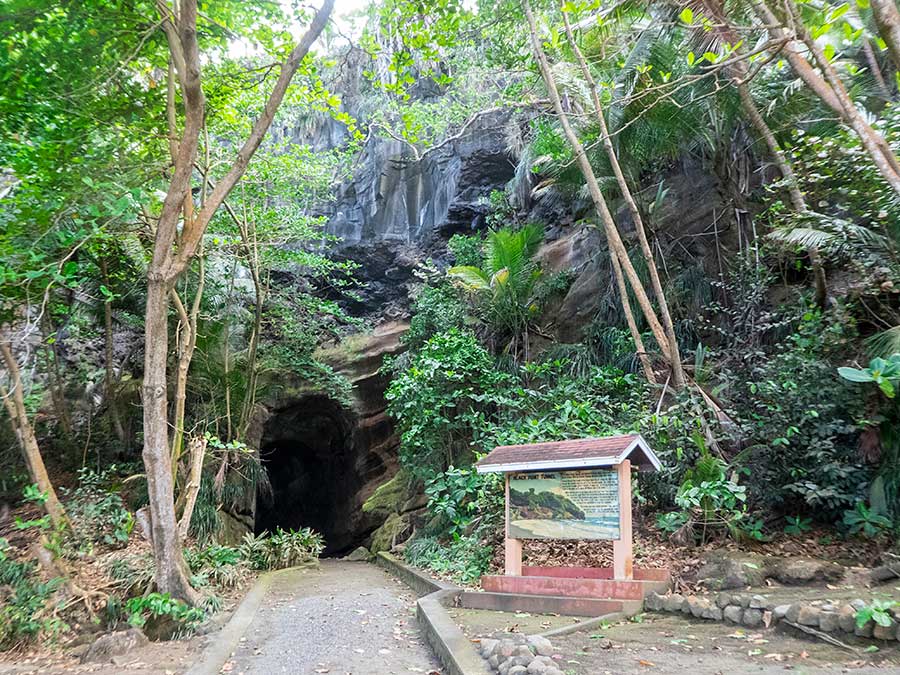Land of the blessed

Mystic of Holyhead (successor to Lynn Rival)
Rachel and Paul Chandler
Tue 15 Mar 2016 01:54
|
13:07.58N 061:11.61W The weather forecast promised a week of unsettled weather so we sailed from Friendship Bay around the windward coast of Bequia and headed for St Vincent (just a 12 mile hop). We landed on the south side of the island, where the shelter would be best from the predicted strong northerlies.  Company en route from Bequia to St Vincent St Vincent, on which most of the Grenadines are dependent, is a rugged, mountainous island, and little developed for tourism. The population is only about 70,000. On the south of the island there are a couple of bays suitable for anchoring, where hotels and restaurants line the coast, with various yachting and diving facilities, including a small marina on the shore of Blue Lagoon.  Sunset at the Blue Lagoon We motored into Blue Lagoon, through a shallow pass in the reef, wondering if we'd find somewhere to anchor amongst all the (often vacant) moorings that litter popular anchorages. Very soon we were approached by Brian from a charter company based at the marina who said anchoring was not encouraged and offered us a mooring: "a bargain at 20 US dollars a night". The setting is very pretty, looking out across the reef to Young Island, or south to Bequia, so we acquiesced. Although sheltered, the Blue Lagoon can be rolly when the wind drops and we had a disturbed night so were not in the best of moods the next day. We went ashore to look around the marina which has a small hotel, a restaurant and cafe attached. Over breakfast we chatted to the friendly restaurant manager: our first impressions were of a well run establishment. Fortified we took a minibus into Kingstown, the capital of St Vincent. The 20 minute drive around the winding coast road, with music blaring at full blast, crammed in like sardines, isn't very comfortable but it's a good way to see some scenery and assess the state of the nation. Even though the south coast has a lot of residential and commercial development, including the airport, it is still very lush and colourful, abundant with palms, breadfruit, mango and sea almond trees to name but a few, and flowering shrubs everywhere.  Down town (that's American for the town centre) Kingstown  Not the cinema - Kingstown market Apart from being on the seaside, Kingstown feels more like a provincial market town than a capital city. It's easy to get around on foot, with the docks and cruise ship terminal at one end, not a long walk from the produce markets in the centre and two small cathedrals at the other end. There are many street sellers, mostly hawking fresh produce but only a few historic buildings of note and no really high buildings. All roads on the island lead to Kingstown with no bypass so it's usually full of traffic. There are few signs but everyone seems happy to show visitors where to find things, including the right bus. The Caribs called St Vincent the "Land of the Blessed" which seems a bit optimistic for an island with an active volcano, earthquakes and hurricanes. Of course, none of these threats are very common and the biggest fear is landslides brought on by torrential rain. The hilly island has many fertile valleys. Place names include Evesham Vale and Mesopotamia valley. Being a volcanic island the coastline has few beaches attractive to sunworshippers but is, apparently, very good for scuba diving.  Kingstown viewed from Fort Charlotte During our visit we wanted to see some of the interior, especially in the north which is dominated by the La Soufriere volcano that last erupted in 1979. A road winds it way along either side of the island and stops two-thirds of the way, with no connection to the other side - there are no roads crossing the island east-west. There are trails for hiking but getting to them other than on an organised tour isn't easy. As we found in Carriacou, visitors have to buy a local driving permit and car hire isn't cheap like it was in Trinidad. Since we'd not done much hiking for a while decided to start with an easy trek along the Vermont Nature Trail before tackling the volcano. Brian introduced us to a friend, Bradley, to act as a guide and Bradley's friend, Dwayne, provided transport. The trail starts not far north of Kingstown, along the leeward highway and up a valley on a minor road, but the drive still took almost an hour. We then had a pleasant, gentle walk through the rainforest, on a well marked trail, looking for the elusive St Vincent parrot and, predictably, not finding any. On the way back we visited the Botanical gardens in Kingstown - founded in 1765 - and saw some of the parrots there in captivity.  A buttressed giant, and Bradley  "Just call me tufty" - a crested hummingbird  The trombone tree?  Back in town - the botanical gardens  Which claim to be the oldest in the west - and there were plenty of ancient looking trees  Vince, the national bird The forecast stormy weather finally arrived so we stayed on board for a day of rain before getting up early to go to the volcano. Dwayne picked us up and drove us around the windward road to the trailhead. Bradley was supposed to meet us but was late so we started on our own. The first half of the trail goes through georgeous rainforest, teaming with birds and flowers and though steep is well-maintained. Unfortunately it started to rain, hard enough to turn the trail into a stream, but we soldiered on and eventually reached the higher zone where the rainforest gives way to tropical montane vegetation. Here tree ferns and many exotic flowering shrubs cover the terrain - apart from the lava flows, one of which we were following - all the way up to the volcano. At this point the trail is more rocky and uneven but still not really difficult, although at times the rain gave way to hailstorms!  A brief pause in the rain as we reach the shelter!  Onward and upward Eventually Bradley - wearing the favoured footwear of local guides (slip-ons!) - managed to catch us up, expressing surprise us oldies had got so far so fast. It was still raining so we made our way up to the crater worried that it would be shrouded in mist (as it often is). Luckily for us, the cloud cleared when we got to the top so we had a fabulous view of the crater and both sides of the island down to the coastline.  Wow - looking down into the crater  Would somebody please wring us out?  One last look down into the crater . . .  . . . and over the endless rainforests to windward, before we set off down hill On our way down we met a large group of cruise ship passengers, some of whom didn't look as if they'd make it to the top - not helped by the coming mid-day heat - let alone all the way back. By the time we got to the trailhead after 5 hours hiking our legs were telling us to stop. We were happy to get into Dwayne's jeep for the drive back down the coast road, stopping only to look at the Black Point tunnel, built in 1815 to transport sugar from the northern plantations through a headland to the adjacent bay for transfer to ships. Still in very good condition it's an impressive and somewhat spooky reminder of the era when slave labour was the norm.  The sugar tunnel, built by slaves in 1815  Still in good nick, despite being in an active volcanic area The next day our legs were aching but it was Saturday, so we took the bus to Kingstown for the produce market. It was well worth the trip, with stalls both inside the market building and outside, lining the streets selling local fresh produce at very good prices. Although much smaller, it certainly compares well with the central market in Port of Spain and brightens up Kingstown, which is otherwise a rather drab place. On Sunday we were preparing to leave. The weather was still a bit unsettled but the strong northerly winds had passed. We had enjoyed St Vincent very much. It has beautiful scenery and friendly, unassuming and down-to-earth people. We also enjoyed the facilities around the Blue Lagoon, with a number of good eateries to choose from. Surprisingly, the small marina/hotel had three separate facilities - a restaurant, cafe and bar - all of which were excellent and not expensive compared to what we've become used to in this part of the Caribbean. |